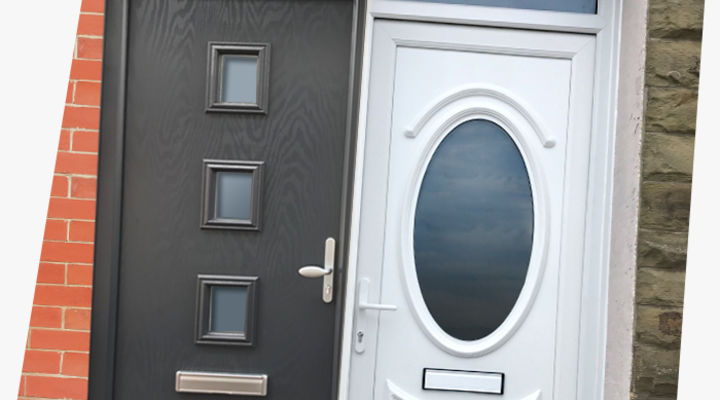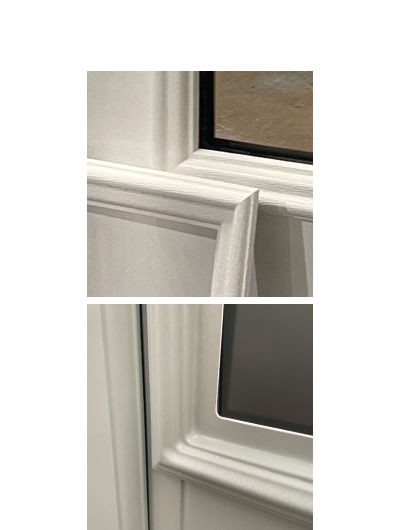The differences between composite and UPVC doors

What are the main differences between composite & UPVC external doors?
The difference between each door is a matter of taste and budget, each with its own benefits but both making effective additions to the front or back of any home.
Different surfaces
White UPVC doors have a smooth surface, while other colours will have a grained effect. For composites, the surface is grained for all colours and it has a wood-like appearance. Our composites use UPVC frames, but this does not clash with the look of the door.
Different weights
UPVC doors are lightweight, making them easier to fit, while composites are heavier and sturdier.
Different costs
UPVC doors are generally cheaper than composite doors, with a base cost door ranging between £400 supply only to over £1000 fully fitted. Our standard composites can cost between £600 supply only and over £1600 fully fitted. Stable composites generally cost £400 more, and Rock Doors up to £2300 without extras.
Different ranges of finishes
UPVCs have a small selection of finishes, these are – white, chartwell green, anthracite grey, black, and the woodgrains rosewood, oak (also known as golden oak) and irish oak. Except for irish oak, composites come in the same range of finishes and more, such as olive (also known as french grey), poppy and aubergine. We even offer a bespoke colour service for composites, opening up more possibilities.
Both offer a variety of styles
Whether you like traditional or modern designs, there is a wide choice of front and back door and glass styles available with our composite and UPVC doors, making them perfect for matching any home aesthetic.

Where did composite and UPVC doors come from?
In short, they were both designed to replace the wooden door, offering economical advantages along with a wide range of options to match.
UPVC Doors originated in Germany
Before its use for doors, UPVC was used for windows, which were first commercially available in Germany in 1959. Due to the low price and greater durability, UPVC was seen as a viable alternative to wood, which could warp and the paint peel. It was not long after that the versatility of this new material would be applied to doors as well, with UPVC doors first introduced in the 1980s to the UK market by Germany.
Composite doors are more recent
In 1996, Rock Door manufactured the first “composite doors” for the UK market as a replacement for wooden doors. They were designed and purpose-built to offer greater security and style, as well as the convenience of finishes that wouldn’t have been possible for wood without the use of paint, which could peel off or wash away.
Both were designed as alternatives to wooden doors
Composites and UPVCs were intended as economical replacements to wood, bypassing wood’s natural disadvantages and offering greater resilience in the face of everyday use. Composite and UPVC front and back doors come in a myriad of styles, and with colourful, long-lasting finishes.
Why are they called “composite” and “UPVC” doors
Composite and UPVC are named after their respective materials, or more accurately in the case of the former a combination of materials.
“Composite” means a variety of materials
The term “composite” refers to a mixture of different materials. These include a rigid GRP skin (short for glass reinforced plastic) on the surface, a timber subframe and a PU (polyurethane) core. These layers are particularly beneficial for insulation.
UPVC is plastic
UPVC stands for “unplasticised poly-vinyl chloride”. PVC by itself is lightweight and flexible, while “unplasticised PVC” means that no plasticiser (softener) has been added. An alternative term is PVCU, which is mainly used in continental Europe as many languages would have the U after the PVC.
How are composite and UPVC doors made?
Both types of door are made with multiple layers, but they differ in how glass is added.
Composite doors are constructed with different parts
Composites consist of a slab, glass panels and a frame. The slab is the main body of the door, with shapes cut into it to house the glass. Because of this, the glass is easy to fit and replace if necessary, and is sealed within the door using cassettes.
UPVC doors are like a sandwich
A panel, sash and frame make up a UPVC door. The outer sides of the panel start out as flexible plastic sheets, each heated within a mould to conveniently create the panel’s distinct design, and then cooled off to harden. The layers of the panel are sandwiched together. Because the glass is integrated into the panel, it cannot be replaced without replacing the whole panel.

What makes composite and UPVC doors better than wooden doors?
There are many reasons why composite and UPVC are favoured over wood, not only due to the wide possibilities of design, but also because of their reliability in everyday use.
A diverse range of styles
Composites and UPVCs are available in a variety of traditional and contemporary styles, as well as colours, making them an easy replacement for any standard wooden front or back door. And what's more, ours are available fully fitted by experts, or supply only for the DIY savvy.
Energy efficiency
The multiple layers within composites and UPVCs, including the glass units with their warm edge spacer bar technology, help to reduce heat loss, whereas single layered wooden doors allow heat an easier path to escape.
Designed for security
Our composite and UPVC doors include Yale brand multi-point locking systems as standard, with hooks and bolts engaging along different sections of each door for more thorough protection than a single-point locking system. We also use toughened glass, which is resistant to square-on impact.
More weather resilient
These doors stand up to the British weather, rain or shine. Each has a weatherproof surface that won’t soak up water and deform, as the case would be with wood.
Built to last
Composites and UPVCs look like new for longer, having weather and fade resistant surfaces you won’t need to repaint, which are UV stable and easy to maintain.

